Best Things to Do in Rocky Mountain National Park - Travel Guide
Everything You Need to Know to Craft the Perfect Rocky Mountain National Park Itinerary
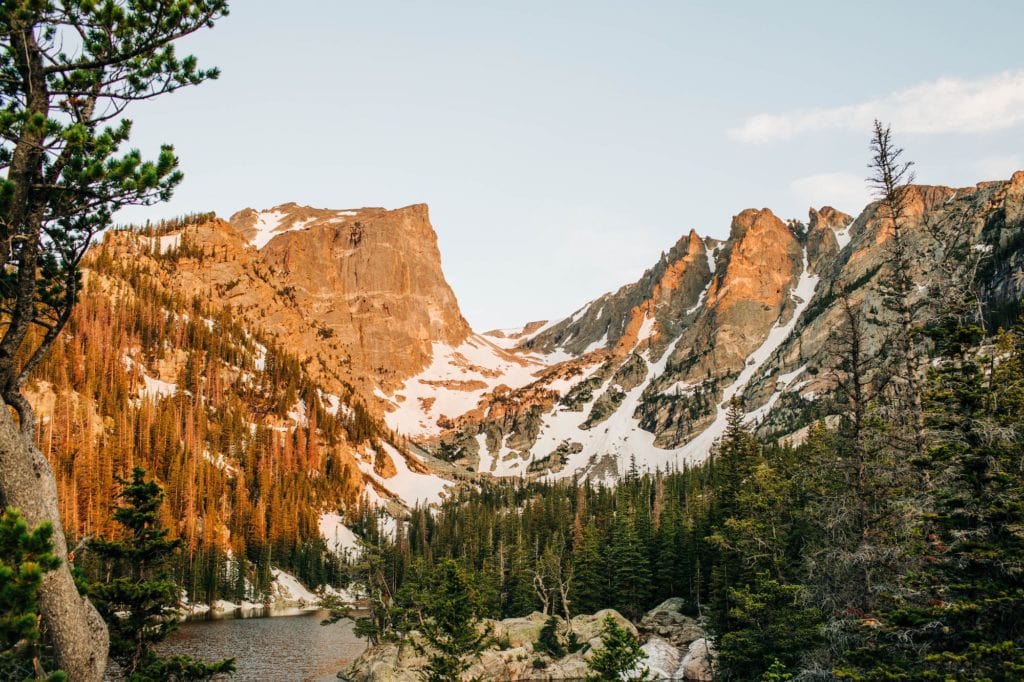
Best Things to Do in Rocky Mountain National Park
A Colorado Local's Guide to Crafting Your Rocky Mountain National Park Itinerary
As a Colorado local who lives about an hour outside of Rocky Mountain National Park, I spend much of my free time exploring this park. I’ve visited and hiked in Rocky more times than I can count, and from my adventures I’ve come up with a curated list of the best things to do in Rocky Mountain National Park.
Here’s the thing: Rocky is huge, and there are so many epic trails, drives, and overlooks to see. I’ve visited this park countless times, and even I have yet to see it all.
This Rocky Mountain National Park guide is going to focus on the highlights and must-see spots, particularly for first-time visitors.
I want you to be able to see the best-of-the-best when visiting our special park, and that’s what this travel guide is intended to do.
In this Rocky Mountain National Park itinerary and travel guide, I’m going to answer the most common questions about visiting Rocky, so you can plan with confidence.
From there, I’ll dive into a list of the best things to do in Rocky Mountain National Park when you visit.
This is a comprehensive Rocky Mountain National Park guide that goes over everything you need to know to plan the perfect trip.
It’s long, I know. But my hope here is that you can find everything you need on this one page and that it can be your go-to when putting together your Rocky Mountain National Park itinerary.
Why Trust My Guide
And This List of the Best Things to do in Rocky Mountain National Park?
I get it, tons of people write guides on Rocky Mountain National Park. Why bother reading mine?
Because Rocky Mountain National Park is basically my backyard. I see it in the busy season. I see it in the slow season. I’ve seen it at sunrise, sunset, and everything in between.
I visit the places in this list year over year, and know their patterns. I know the most visited spots and how to navigate crowds.
All of this to say, I’m here to make sure you see the best of Rocky Mountain National Park during the short time you’re visiting, and I can give you some tips and tricks to cut down on cost and have the best park experience possible.
Some Important Information About Rocky Mountain National Park
Common Questions + Important Planning Tips
Rocky Mountain National Park (“RMNP”) covers 265,769 acres, so as you can imagine, it spans more than a single Colorado town.
Most people who visit Rocky Mountain National Park visit the park through the Estes Park side, but the park also covers part of Grand Lake, Colorado as well. All of this will impact where you choose to book your lodging, but more on that later.
Rocky Mountain National Park is the 4th most visited national park in the US. So yes, it is busy. When people think of Colorado, this park is one of the first places that comes to mind.
That said, it is completely possible to find peace and quiet in Rocky (I do it all the time, and I’ll show you how!). It’s simply a matter of knowing what time of year, what day of the week, and what time of day to go. All of these factors play a big role in your experience in the park. I’ll speak to this later on.
Rocky Mountain National Park encompasses a wide range of elevations. The lowest point in the park is 7,860 feet above sea level and the highest point is Longs Peak (one of Colorado’s 58 14’ers), at 14,259 feet.
Altitude sickness is a very real thing. I’ll start by saying, I am not a medical professional and I can’t provide medical advice (disclaimers are fun, right?!).
But my top tip for feeling your best when planning your Rocky Mountain National Park itinerary is to give yourselves 48 – 72 hours to get acclimated to the elevation.
That means, when you fly in, spend a day in Denver (elevation 5,280 ft). Then spend the next night in Estes Park (elevation 7,522 ft). And then, you can head into the park the next day and explore the higher elevations.
You’ll also want to start drinking plenty of water as well. You’ll be surprised how quickly you’ll feel dehydrated when you’re out here. All of this will help with those nasty elevation headaches.
All of that said, if you’re experiencing symptoms of altitude sickness, please go to a lower elevation and keep an eye on your symptoms.
This ultimately depends on which park entrance you’re going through. Are you planning on driving from Denver to the Estes Park side of Rocky Mountain National Park? You can anticipate it to take around 1.5 hrs, without traffic.
If you’re planning to drive from Denver to the Grand Lake side of the park to get to the Kawuneeche Visitor Center, it’ll be around 2 hrs without traffic.
Well, how long do you want to stay in the park? A single-day pass will cost you $25 per vehicle. For a week-long pass, you’ll pay $35.
But in my honest opinion, if you’re the type of person who plans on visiting a few national parks within the year, invest in the America the Beautiful pass.
With the America the Beautiful pass, you pay a one-time fee of $80 for the year and get access to all the national parks (and some additional federal recreation lands, too!) for the next 12 months.
This is what I do every year, and it more than pays for itself. This pass is not to be confused with the Rocky Mountain National Park Annual Pass, which costs $70. Don’t bother with that one when you can pay $10 more and get access to all the other national parks.
Hold up a sec, though, because entry into Rocky Mountain National Park has unfortunately gotten a bit more complicated lately. The park has instituted a timed entry system during peak season, where you have to reserve a two-hour window when you plan on entering the park.
Once you enter into the park during your two-hour ticket window, you’ll good for the rest of the day, though. Here’s how it works.
There are certain hours when you don’t need timed entry. For the Bear Lake Corridor, this is after 6 PM and before 5 AM. For the rest of the park, this is after 3 PM and before 9 AM.
Timed entry tickets open up the first day of the month for the following month. So, for example, if I want timed entry for July 15, I need to reserve my time on June 1. And let’s just say, these timed entry tickets sell out within minutes, so you literally want to be sitting at your computer at the exact minute they open (which is at 10 AM Mountain Time).
Didn’t get a timed entry ticket the first go-around? It might be okay. Here’s why. The park does release a select number of tickets the day before for each date, and those tickets are released at 5 PM Mountain Time. So, if I didn’t get a ticket for July 15, I’ll wait until July 14 at 5 PM Mountain Time and try to snag it then.
Complicated? I know, but in theory, it should cut down on crowds in the park, which should allow for you to have a more private experience.
Rocky Mountain National Park itself is open 24/7, weather-permitting, but entrance stations and visitor centers are not, and do have their own designated hours that vary by the season.
Typically hours for entrance stations and visitor centers are shorter during the winter season and longer during the summer.
It is common for certain parts of the park to close due to weather conditions. Trail Ridge Road is the most notable example of this, as the road shuts down for the winter and usually re-opens on Labor Day weekend. It then will close around mid-October.
Similarly, if dangerous weather conditions exist, Rocky Mountain National Park will close down roads as needed to protect visitors.
Rocky Mountain National Park has four visitor centers and a few informational centers as well.
The visitor centers include the Beaver Meadows Visitor Center, the Fall River Visitor Center, the Alpine Visitor Center, and the Kawuneeche Visitor Center.
The information centers include: the Moraine Park Discovery Center (closest to the Beaver Meadows Visitor Center), the Sheep Lakes Information Station (closest to the Fall River Visitor Center), the Holzwarth Historic Site (closest to the Kawuneeche Visitor Center), the Bear Lake Information Station (closest to the Beaver Meadows Visitor Center), and the Longs Peak Information Office (you won’t pass by a visitor center to get to this one from Estes Park).
There are two visitor centers in Estes Park: the Beaver Meadows Visitor Center (this is the busiest one in the park) and the Fall River Visitor Center.
If you’re looking to avoid long entrance lines, I highly recommend entering the park through the Fall River entrance instead of the Beaver Meadows entrance.
If you intend to drive Trail Ridge Road, it only adds on a small amount of time to your travel. If lines are long (which you can check beforehand, by viewing one of Rocky Mountain National Park’s many webcams), it can totally be worth it.
Then, on Trail Ridge Road, which typically opens on Labor Day Weekend and typically closes in mid to late October, there is the Alpine Visitor Center, sitting at 11,796 feet in elevation.
While Estes Park is the town most people think of when they think of visiting Rocky Mountain National Park, Rocky is also in Grand Lake, Colorado as well. This is where you’ll find the Kawuneeche Visitor Center.
While there are a few information centers also sprinkled throughout the park, these four are the actual official visitor centers for Rocky Mountain National Park.
Best Time to Visit Rocky Mountain National Park
When Putting Together Your Rocky Mountain National Park Itinerary, What Time of Year Should You Plan For?
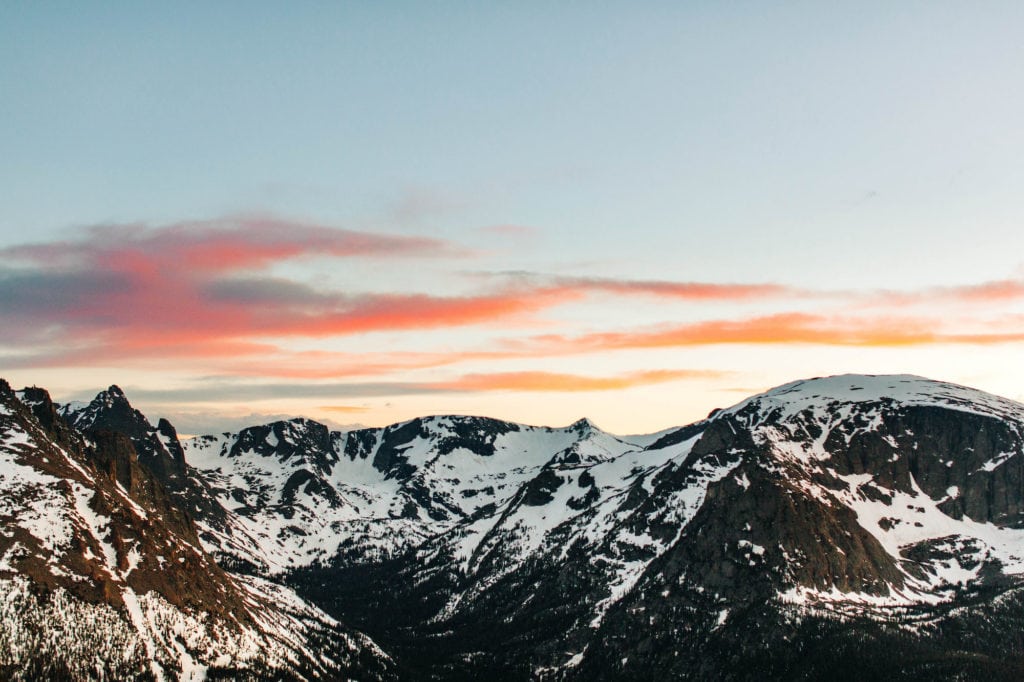
The Busy Season
Rocky Mountain National Park in Summer and Early Fall
The best time to visit Rocky Mountain National Park really depends on what you hope to get out of your experience.
If you want to be able to drive the full length of Trail Ridge Road (the highest elevation continuous highway in the entire United States), you’ll want to plan your trip to fall between Memorial Day weekend and sometime before mid-October, as the road shuts down in the colder months.
That said, I’d aim for mid-June at the earliest and end of September at the latest. Trail Ridge Road is known to close with adverse weather conditions, even in the summer months, since the road goes over 12,000 ft in elevation.
During June, July, and early August, the park is at its greenest. In June, you’ll start to see wildflowers blooming at certain elevations, and that continues at higher elevations as you go farther into the summer months. Towards the end of August, things begin to start drying out for fall.
The alpine tundra on Trail Ridge Road will turn more golden in color, and there’s a chance snow might happen here and there. The second half of September is known for fall colors at elevations where aspen trees grow.
All of this to say, the summer months and the beginning of fall are the busiest times of year to be in Rocky Mountain National Park. This is peak season.
Minimize crowds by planning your trip on a weekday and aim to be in the park well before sunrise (especially if you’re visiting the Bear Lake Corridor, which includes Sprague Lake, the Bear Lake Trailhead, and the Glacier Gorge Trailhead).
The other alternative is to visit around sunset, when most people are back in town having dinner. That said, going at sunset works best when you’re not planning on doing much hiking. I personally prefer sunrise during Rocky Mountain National Park’s busy season.
It’s also worth noting, if you’re planning on tackling Longs Peak, you’ll want to start well before sunrise. The parking lot for this 14er is always packed in the early morning. And you don’t want to be hiking above tree line in the afternoons, because of how likely afternoon thunder and lightning storms are in the summer months.
These storms are quite literally life threatening, so you want to avoid hiking at very high elevations in the afternoon.
The Hidden Gem Season
Rocky Mountain National Park in Winter
Winter is the off season in Rocky Mountain National Park, but it’s a total hidden gem for those willing to put up with chilly temps and snow.
Honestly, many of the most iconic spots in Rocky are prettiest in the winter. You get snow-covered trails, frozen alpine lakes, and so many less crowds.
If you’re comfortable with driving winding mountain roads in the snow and are prepared for changing plans with adverse weather conditions, Rocky in the winter is a real treat.
However, it’s important to note that Trail Ridge Road connects the Estes Park side of the park and the Grand Lake side of the park, and it is closed in the winter months.
The Not-So-Great Season
Rocky Mountain National Park in Spring and Late Fall
When it comes to the Rocky Mountains, spring can often mean freak blizzards (hello, March in Colorado!) or hail storms. The grass hasn’t gotten green yet and things still look pretty dead.
Now, if you go to higher elevations, it’s a bit different. There’s still snow and everything looks magical, but lower elevations in the park are lackluster.
The same sort of thing applies to the late fall. At that point, weather can swing any which way, but the leaves have fallen off the aspens and everything has dried out for the winter.
Generally speaking, once you start venturing farther into October, Rocky Mountain National Park isn’t as pretty. But, like I said earlier, wait until winter and you’ll be rewarded! Once that snow starts falling, it’s stunning.
What to Do in Rocky Mountain National Park
Epic Hikes and Sights to Add to Your Rocky Mountain National Park Itinerary
How Many Days in Rocky Mountain National Park?
How Much Time Do You Need?
When planning your Rocky Mountain National Park itinerary, I’d recommend spending at least 3 days in the park, and ideally a full week.
Do You Prefer Hiking to Your Destination or Driving There?
Your Itinerary Will Vary Based on Your Preference
I’ll make sure to include a variety of drive-up overlooks and hiking trails, so you have options when crafting your Rocky Mountain National Park itinerary.
Disclosure: I’ve included lodging recommendations near Rocky Mountain and gear recommendations for your journey in this article.If you choose to purchase gear or book lodging through my links, I may earn a commission, at no cost to you.
Shopping through my links helps support this small Colorado business and is greatly appreciated. This content is crafted with love, from selling platforms I use and trust myself.
3M Curve
The Perfect Roadside Stop With Views of Moraine Park
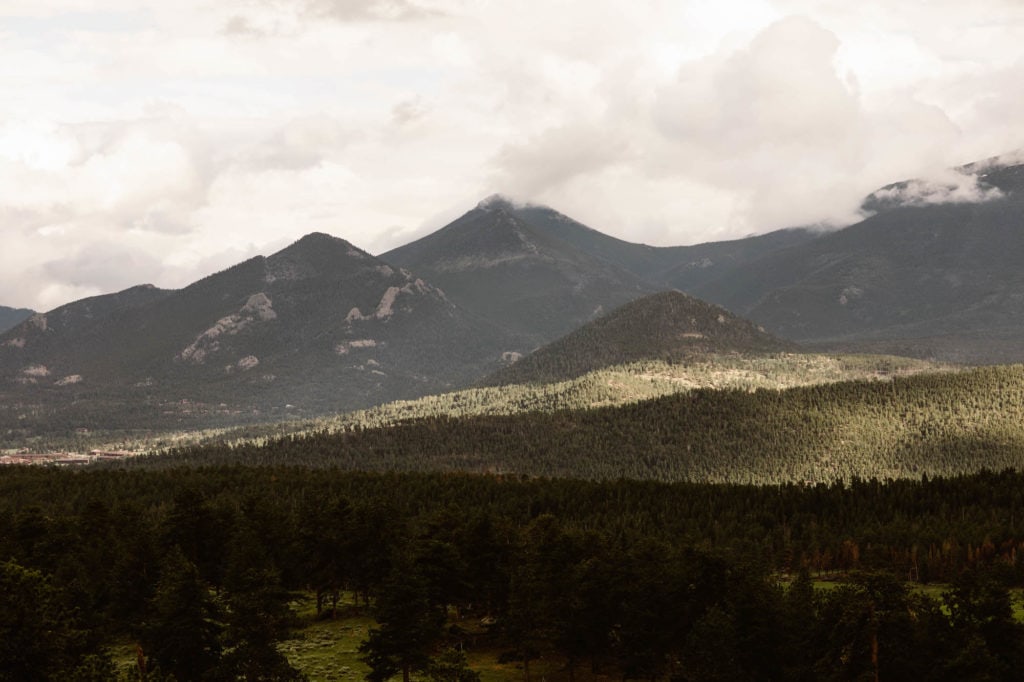
3.5 miles after entering Rocky Mountain National Park from the Beaver Meadows Visitor Center you’ll come across 3M curve.
This stop is at a pull-off situated along a curve in the road and offers expansive views of Moraine Park’s meadows, with Longs Peak as a backdrop.
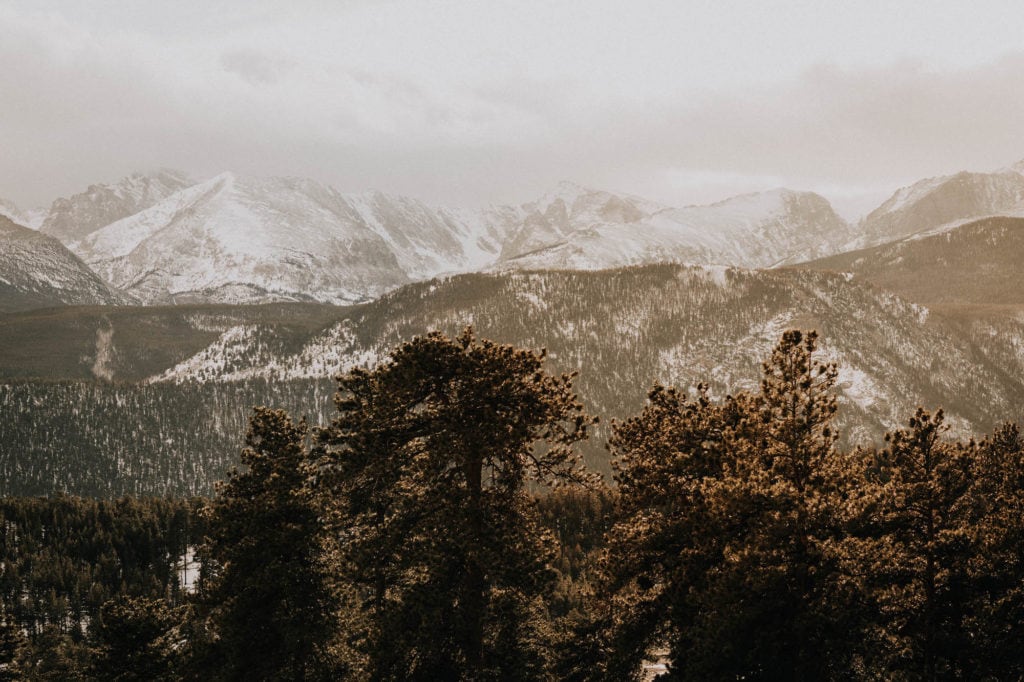
Open throughout the year, you’ll be met with lush greens in the summer and snow-speckled meadows in the winter. Spring and fall are a bit more variable, but the views are worth drinking in whenever you visit.
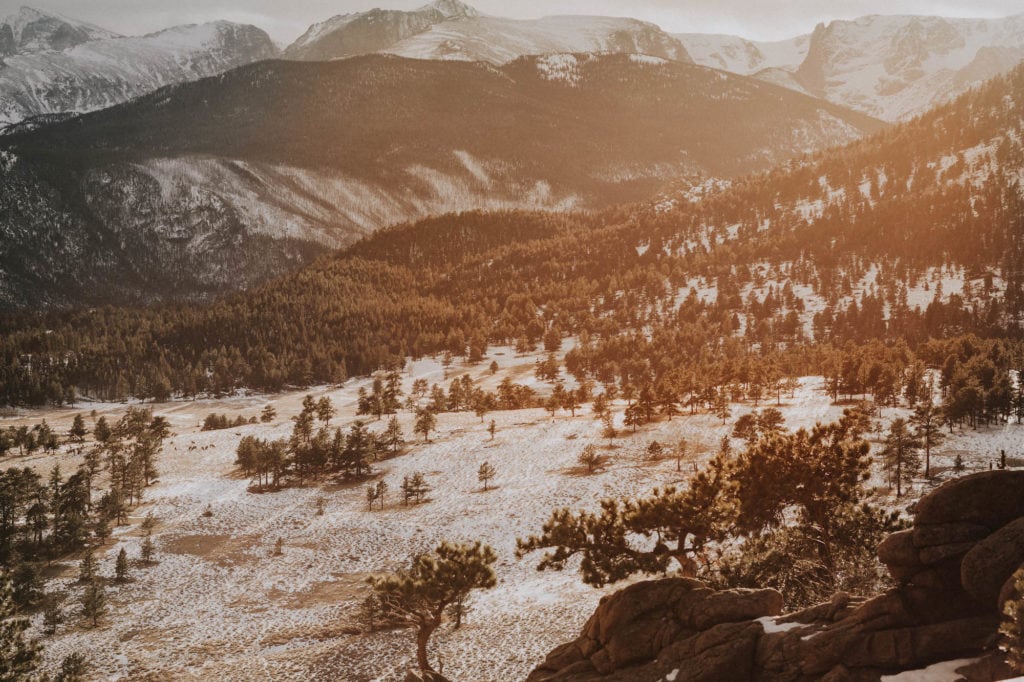
Note that 3M curve is not marked with road signage, but a rock outcropping on the down-slope side of the road should help you find the pull-off (also on the down-slope side) without too much trouble.
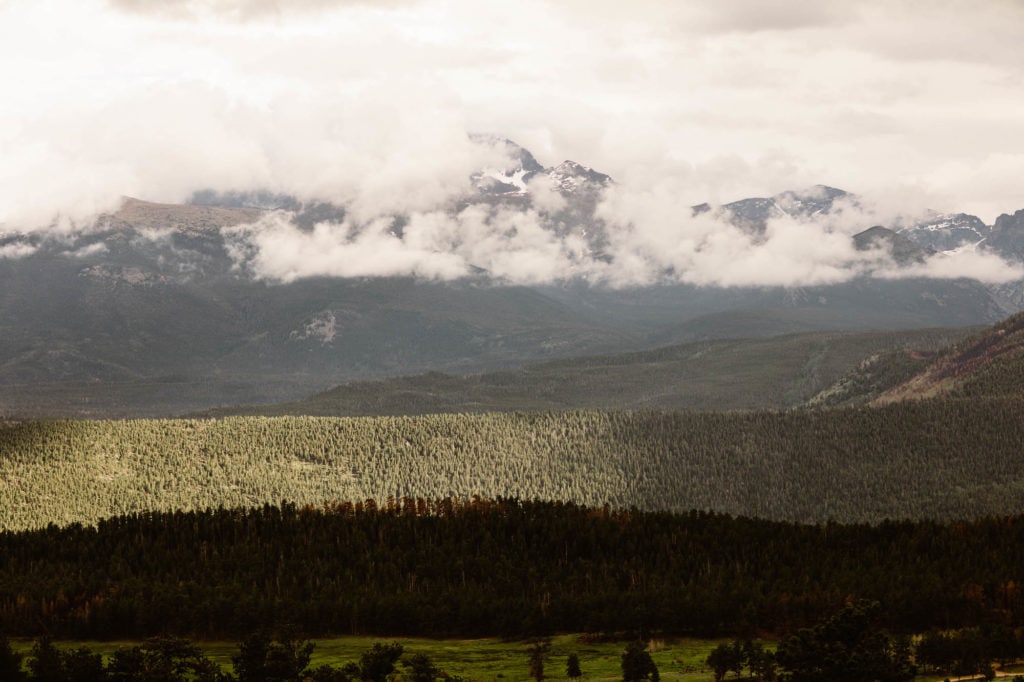
3M Curve is also a designated wedding ceremony in the spot, so if you happen upon a couple eloping here, please make sure to give them space! There are plenty of epic viewpoints that aren’t the ceremony spot, so you have lots of options!
Moraine Park
A Classic Rocky Mountain View
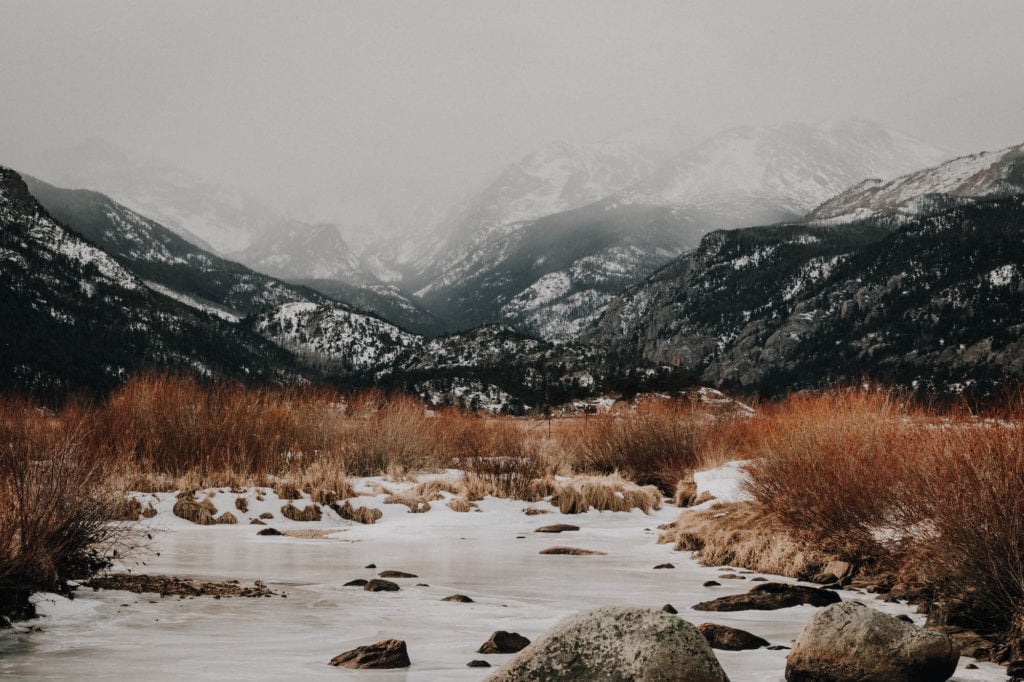
Moraine Park is one of the first areas you’ll see when entering the park from the Beaver Meadows Visitor Center.
A valley separating the Bear Lake corridor from the rest of the park, Moraine Park has access to many of the trails weaving their way throughout the eastern half of Rocky Mountain National Park.
From this area, you can find trails that will take you high onto Trail Ridge Road, over to the Bear Lake trail system, or just around the Moraine Park area.
On its many tails, you’ll be able to find whatever draws you to nature during some point of the year: hiking, snowshoeing, wildflowers, or mountain streams.
If you’re looking for an easily accessible place to admire the Rockies, Moraine Park is an awesome option.
Sprague Lake
A Lovely Mountain Loop Trail // Wheelchair Accessible

Sprague Lake Trail is one of the most approachable hikes in all of Rocky Mountain National Park. Along the Bear Lake Corridor, the trailhead is just 7.5 miles beyond the Beaver Meadows Visitor Center.
An 0.75 mile loop encircling the lake, the trail is very flat and made of a hard-packed gravel surface making Sprague Lake a good option for small kids, those that haven’t acclimated to the elevation, and is also one of the park’s wheelchair accessible trails.
I personally love how magical Sprague Lake looks in the winter time, and in summer, you’ll find wildflowers dotting the trail as well!
P.S. We’ve written a full guide to Sprague, with all the details you need to know about visiting this spot in Rocky Mountain.
Bear Lake
A Great Alpine Lake to Watch the Sun Set // Wheelchair Accessible*
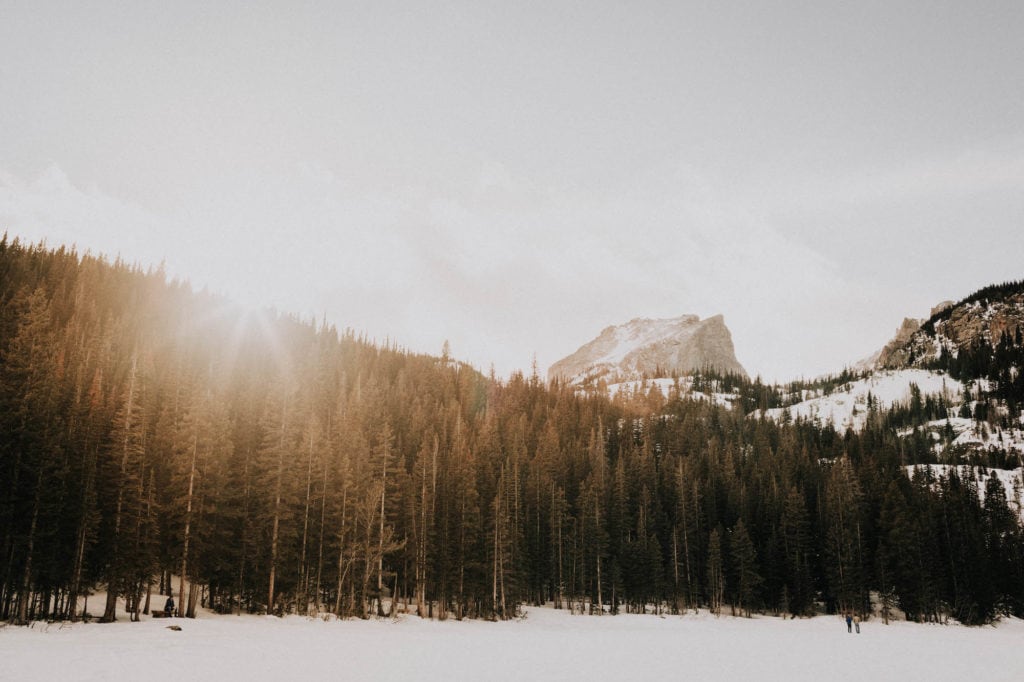
Bear Lake is one of Rocky Mountain National Park’s most iconic spots. Bear Lake Trail loops around the lake and has intermittent outlooks with views of the lake and rugged peaks of the surrounding mountains in the background.
This trail is also approachable for kids, non-hikers, and those not completely acclimated to the elevation, as it’s a short distance from the trailhead to the first water overlook and has virtually no elevation gain.
Bear Lake Trail itself takes less than a mile to loop around the lake, but there is a whole system of trails sprouting out from this point.
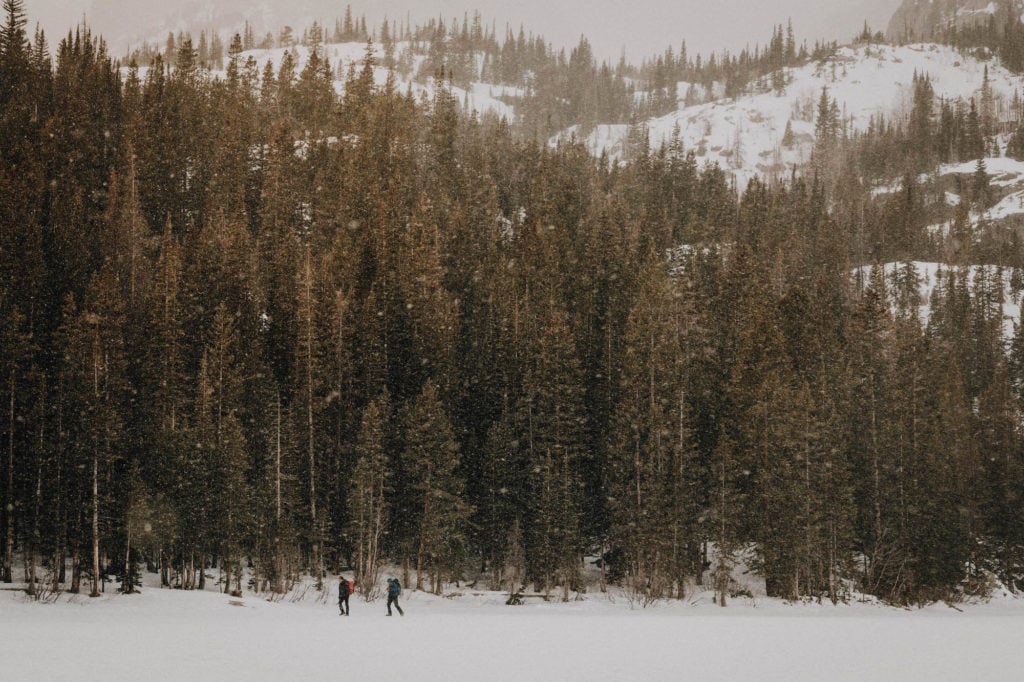
There is a string of lakes all the way to Emerald Lake, the end of the Bear Lake Corridor. Along the way you’ll pass Nymph Lake (known for its covering of lily pads) and Dream Lake, and can opt to take a spur in the trail towards Lake Haiyaha.
Bear in mind that the Bear Lake Trailhead is quite busy, and parking is nearly impossible to find in the peak season on weekends. My recommendation is to arrive around sunrise to snag a spot or be prepared to take the shuttle when the parking lot is full.
*Rocky Mountain National Park lists that Bear Lake Trail is wheelchair accessible, however that’s really up for debate. There are several reviews from people who took to this trail in wheelchairs and noted that parts of the trail were too narrow to navigate.
Dream Lake
An Iconic Rocky Mountain National Park Trail
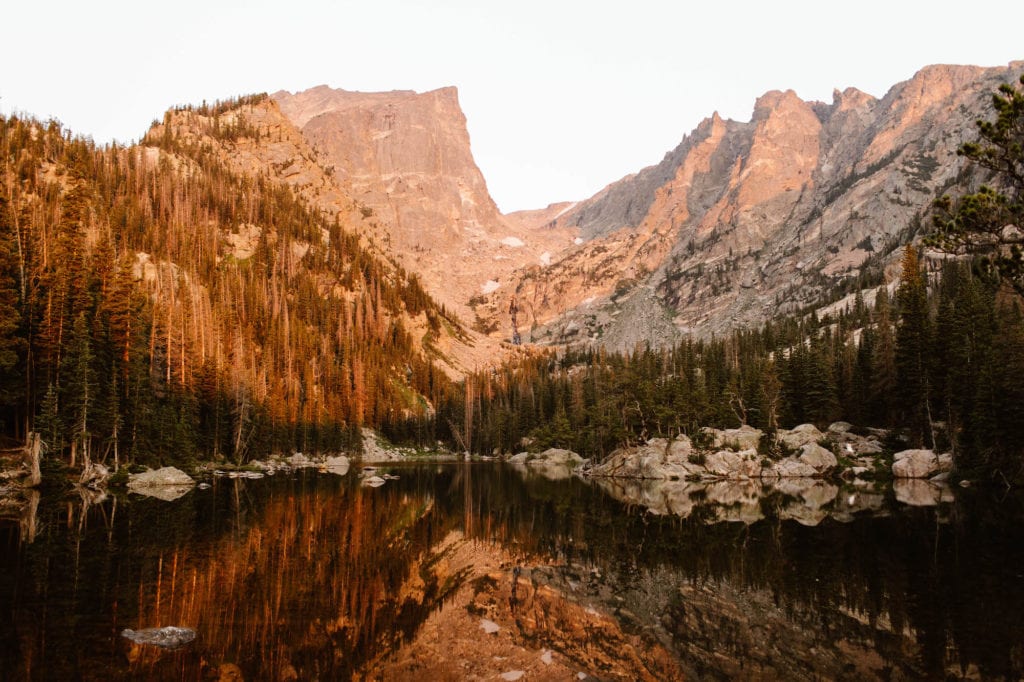
Dream Lake is one of those lakes on the path towards Emerald Lake, shooting out from the Bear Lake trailhead. Out of all the lakes in Rocky Mountain National Park, Dream Lake is one of my favorites.
Once arriving, you’re rewarded with a view of tall craggy mountains at the other end of the lake. The view looking long-ways across the lake up at the mountains is simply incredible.
I highly recommend hiking up to Dream Lake for sunrise, so you can see the maroon-color alpenglow lighting up the tips of the mountains.
Dream Lake is also a total show-stopper in the winter. Pack your MICROspikes to get up the trail when it’s packed down and slippery, and try your hand at walking across the frozen lake (but please do not attempt this early or late in the winter season when the ice may not be thick enough!).
Trail Ridge Road
The Highest Continuously Paved Highway in the US
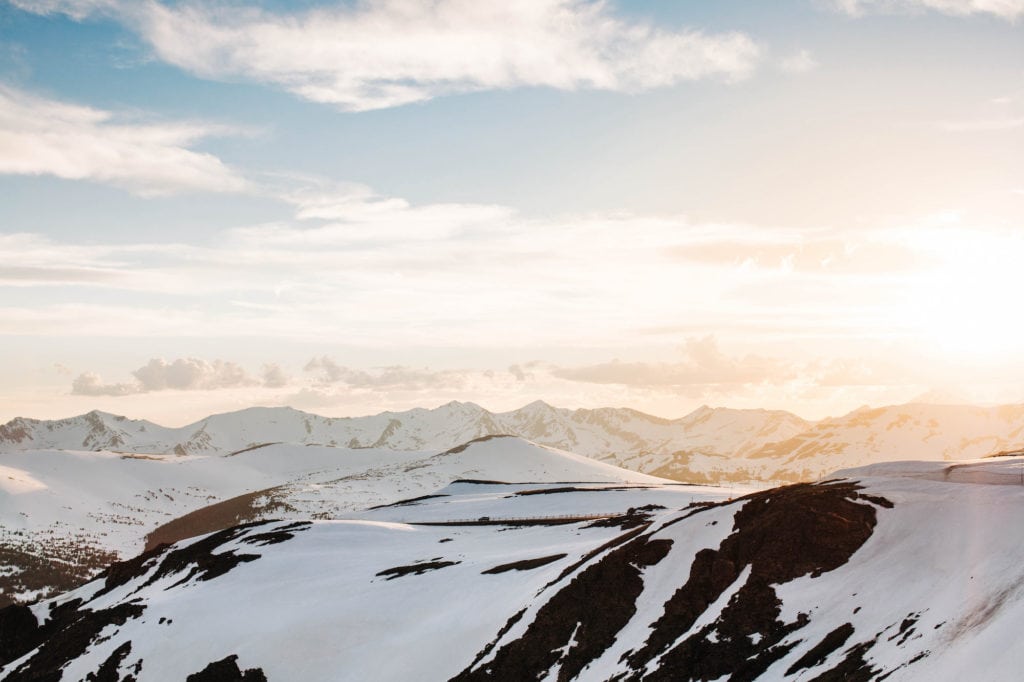
Trail Ridge Road is a 48 mile stretch of road that connects the east and west sides of Rocky Mountain National Park. If you’re driving straight through without any stops, you can expect the drive to take about 1.5 hrs.
But you’ll definitely want to stop at the various overlooks and hiking trails on the way. I’ll include a few of my favorites below!
Many Parks Curve Overlook
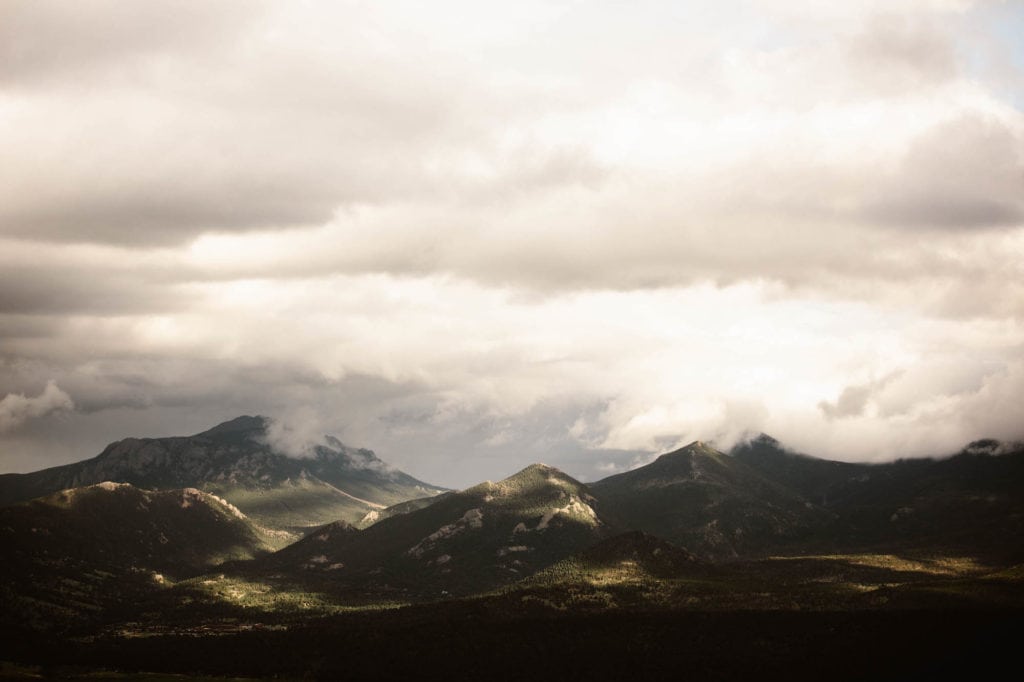
I absolutely love this overlook. On your way up Trail Ridge, you really realize just how high up you are.
You can peek down into the valley below and experience that epic “on top of the world” feeling that Rocky Mountain National Park embodies.
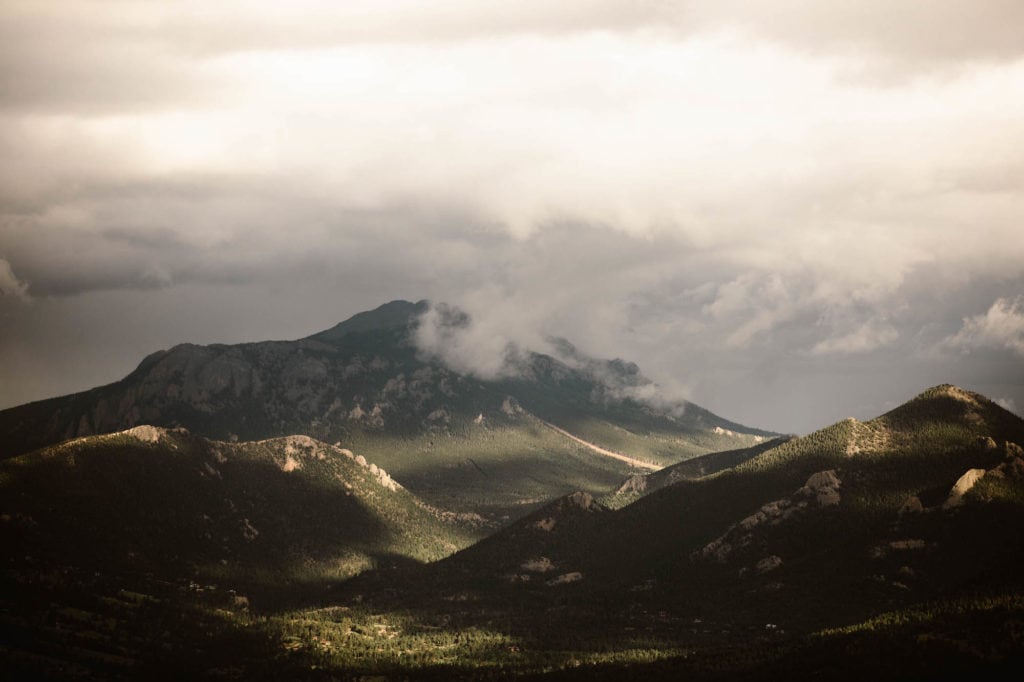
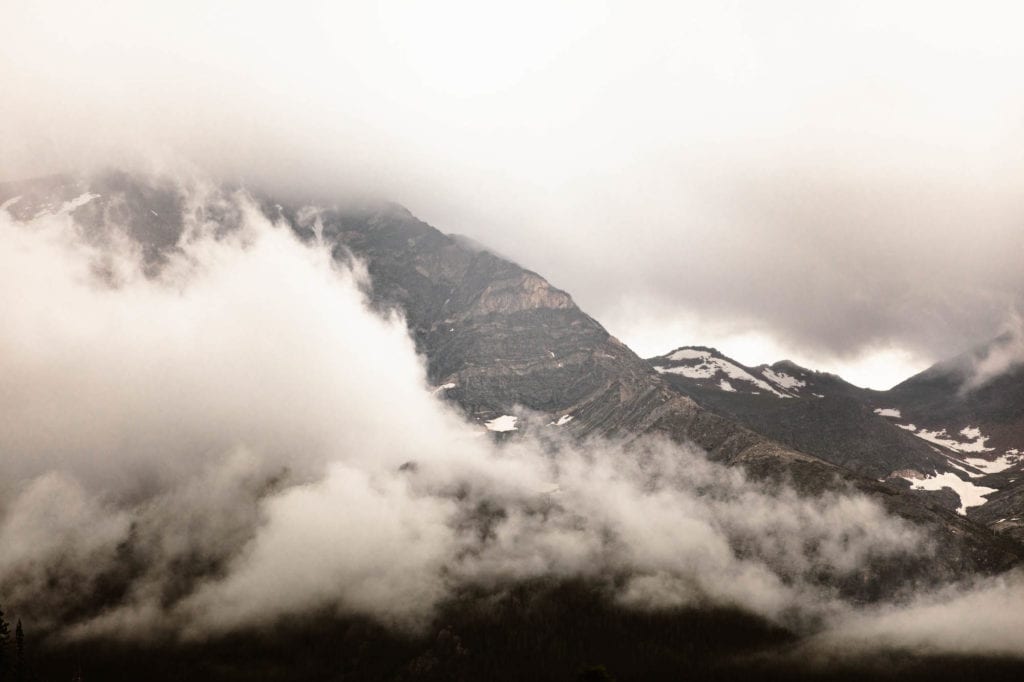
If you’re driving up Trail Ridge going westbound, the parking lot will be a little past the curve on the lefthand side. And if you’re driving down Trail Ridge eastbound, the lot will be right next to the walking platform on the right side of the road.
Forest Canyon Overlook
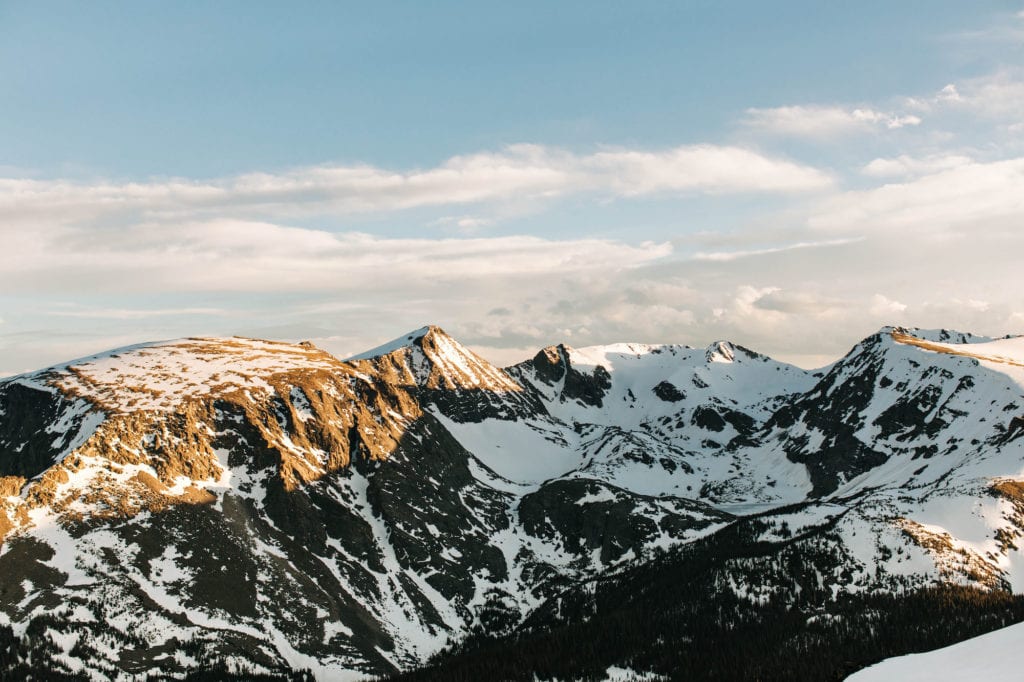
Forest Canyon Overlook is an iconic spot on Trail Ridge Road and one of the first overlooks you’ll come across when you get to the top going westbound.
You get crazy cool panoramic views of the mountains at this spot, and there’s a nice little paved trail that takes you to a circular lookout that’s kind of like a little patio.
At this point, you’re in the alpine tundra, where the plant life can literally take decades to grow, so please stay on the paved trail when visiting these areas!
The Lava Cliffs
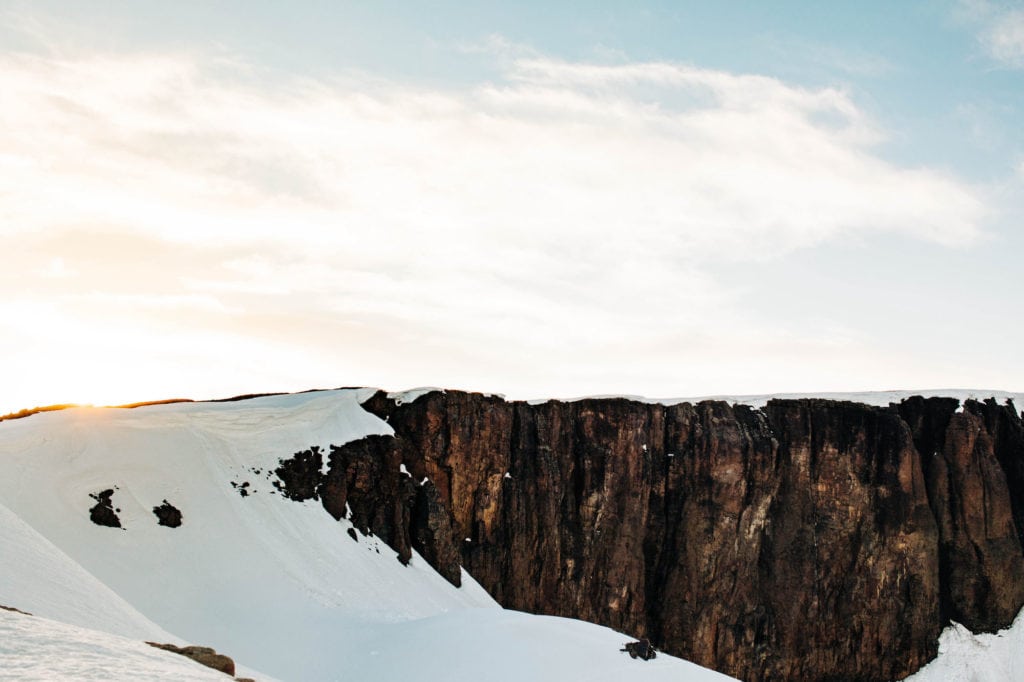
The Lava Cliffs can be seen on one of Trail Ridge Road’s many pull-offs. There’s a decent number of spots to park your car and admire the stunning cliff sides.
I absolutely love the Lava Cliffs since they’re unlike any other view in Rocky. It’s just such a distinct spot, with the dramatic sheer cliff face.
Rock Cut
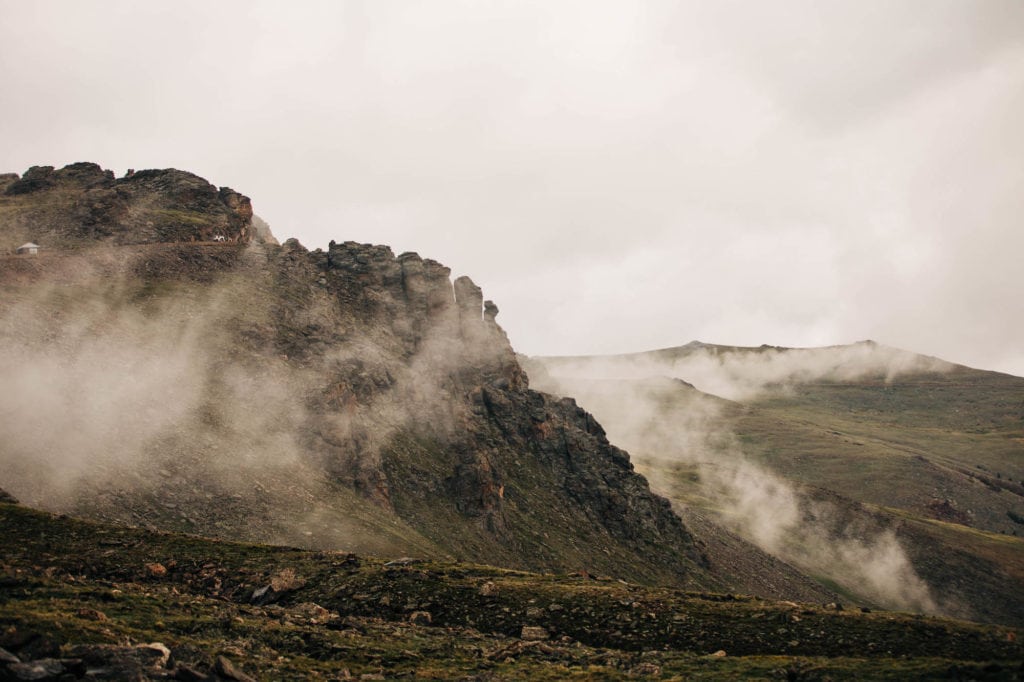
Rock Cut is a great place to stop if you’re interested in getting out and walking a bit.
There’s a short trail, the Tundra Communities Trail, that starts right near the restrooms in this area. This area also has some of my favorite views of the tundra.
There’s parking on either side of the road at Rock Cut. On the westbound side, there’s a little parking lot and on the eastbound side, parallel parking options.
Places to Stay Near Rocky Mountain National Park
My Recommendations for Lodging Near the Park
Lodging in Estes Park
The Closest Town to the East Side of Rocky Mountain National Park
The most iconic place to stay in Estes Park is the Stanley Hotel. It’s actually served as the inspiration for the Overlook Hotel in Stephen King’s the Shining. The Stanley is nice and close to both the Beaver Meadows and Fall River entrances, under 5 miles each.
Another really solid lodging option in Estes is the Estes Park Resort. It sits right on Lake Estes. so if you’re wanting to go on some lakeside adventures, this hotel is awesome. And of course, it’s nice and close to the Beaver Meadows entrance to Rocky.
Nearby Front Range Towns
The Best Places To Book Lodging to Avoid High Estes Park Prices
The reality is, Estes Park is not a large town, but it attracts a ton of tourists. That ultimately means higher lodging costs and less bang for your buck.
If you’re okay with driving an hour or so to get into the park, I’d highly recommend booking lodging in the nearby Front Range towns. These include Fort Collins, Longmont, and Boulder. And honestly, you’ll get some really great lodging options in these towns, without a super touristy feel.
My favorite hotels in Fort Collins include the Elizabeth and the Armstrong. They are hands-down the two most gorgeous hotels in town. Both are located in Old Town with tons of delicious food and coffee a short walk away.
For Longmont, you’ll have plenty of no-frills style hotels, and I personally think Home2 Suites by Hilton is the best option. You get free breakfast, a modern looking hotel, and lower nightly rates than anything of comparable quality you’d find in Estes Park.
Boulder is one of my favorite towns on the Front Range, and totally worth visiting on your time out in Colorado. Plus, it’s not far from Rocky. If you’re looking for places to stay in Boulder, the historic Boulderado is a classic.
For a more luxury experience, definitely stay at the St. Julien Hotel and Spa. It’s the perfect place to relax after a long day of hiking and exploring in Rocky. And it’s another iconic Boulder hotel, and the staff on site are super helpful and kind.
If you want a tucked-in-the-mountains experience that’s a great deal for the Boulder area, the A-Lodge (aka the Adventure Lodge) is a great option.
Hey there, Rocky Mountain traveler! Sheena here.
Outdoors enthusiast and advocate. Adventure elopement photographer. Dog mom extraordinaire. Girl who lives for the sounds of dirt beneath her hiking boots.
Sheena is a Colorado-based elopement photographer who believes in being the go-to adventure wedding resource for the couples she works with. Interested in working with Sheena for your elopement?
Click the button below to schedule your complimentary elopement chat or view the pricing page to see how she can help you bring your dream to life.
Sheena Shahangian Photography LLC
Empowering You To Have Your Adventure Elopement, Your Way
colorado . washington . oregon . utah . california . wyoming